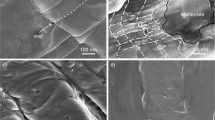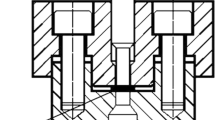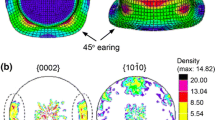Abstract
Micro-scaled progressive sheet metal forming is a promising process for producing bulk microparts, given its advantages of high efficiency and low cost. To enhance forming quality and efficiency, it is important to have an in-depth understanding of the forming mechanism and model the forming process and fracture behavior accurately. However, the prediction of fracture formation in sheet materials at the micro-scale has not yet been well explored, and thus current knowledge is not sufficient to support the continued development and application of microforming technology. This study investigated progressive sheet forming of magnesium-lithium alloy sheets of different grain sizes to produce bulk microparts directly from sheet metal via shearing, extruding, piercing, and blanking. Using the Gurson–Tvergaard–Needleman (GTN) damage model, the effects of the size factor on the formation and evolution of voids were considered, and the shear-modified GTN model was established by combining Thomason’s and Lemaitre’s damage mechanics models. The modified model could predict not only the ductile fracture behavior dominated by tension under high-stress triaxiality at the micro-scale, but also the damage behavior controlled by shear deformation under low-stress triaxiality. The progressive forming process was simulated using the modified model, which was verified by experimentation and simulation. Comparisons of the experiments and simulations revealed the size effects on the forming defects and fracture behaviors of microparts during progressive sheet forming. The results show that the stress during deformation is mainly concentrated at the edge of microparts, and irregular geometric defects including burr, rollover, incline, and bulge become deteriorated with the increase of the initial grain size. This study enhances the understanding and prediction of ductile fracture in the micro-scaled progressive forming of sheet metals.

















Similar content being viewed by others
References
Vollertsen F, Hu Z, Niehoff HS, Theiler C (2004) State of the art in micro forming and investigations into micro deep drawing. J Mater Process Technol 151(1–3):70–79. https://doi.org/10.1016/j.jmatprotec.2004.04.266
Cao J, Brinksmeier E, Fu MW, Gao RX, Liang B, Merklrin M, Schmidt M, Yanagimoto J (2019) Manufacturing of advanced smart tooling for metal forming. CIRP Ann Manuf Technol 68(2):605–628
Jing CZ, Wang JL, Zhang CP, Sun Y, Shi ZY (2022) Influence of size effect on the dynamic mechanical properties of OFHC copper at micro-/meso-scales. Int J Adv Manuf Technol. https://doi.org/10.1007/s00170-022-08674-7
Yang DY, Bambach M, Cao J, Duflou JR, Lee CW (2018) Flexibility in metal forming. CIRP Ann-Manuf Technol 67(2). https://doi.org/10.1016/j.cirp.2018.05.004
Fu MW, Wang JL, Korsunsky AM (2016) A review of geometrical and microstructural size effects in micro-scale deformation processing of metallic alloy components. Int J Mach Tools Manuf 109:94–125. https://doi.org/10.1016/j.ijmachtools.2016.07.006
Tang XF, Shi SQ, Fu MW (2019) Interactive effect of grain size and crystal structure on deformation behavior in progressive micro-scaled deformation of metallic materials. Int J Mach Tools Manuf 148:103473
Chan WL, Fu MW (2013) Meso-scaled progressive forming of bulk cylindrical and flanged parts using sheet metal. Mater Des 43:249–257. https://doi.org/10.1016/j.matdes.2012.07.004
Fu MW, Chan WL (2013) Micro-scaled progressive forming of bulk micropart via directly using sheet metals. Mater Des 49(Aug.):774–783. https://doi.org/10.1016/j.matdes.2013.02.045
Qiu TT, Hou YK, Cao HL (2017) Review of research progress on size effect in micro-forming. Key Eng Mater 717:118–121. https://doi.org/10.4028/www.scientific.net/KEM.717.118
Fu MW, Wang JL (2021) Size effects in multi-scale materials processing and manufacturing. Int J Mach Tools Manuf 167:103755. https://doi.org/10.1016/j.ijmachtools.2021.103755
Engel U, Ec Kstein R (2002) Microforming—from basic research to its realization. J Mater Process Technol 125:35–44. https://doi.org/10.1016/S0924-0136(02)00415-6
Miyazaki S, Shibata K, Fujita H (1979) Effect of specimen thickness on mechanical properties of polycrystalline aggregates with various grain sizes. Acta Metall 27(5):855–862. https://doi.org/10.1016/0001-6160(79)90120-2
Chan WL, Fu MW (2012) Studies of the interactive effect of specimen and grain sizes on the plastic deformation behavior in microforming. Int J Adv Manuf Technol 62(9–12):989–1000. https://doi.org/10.1007/s00170-011-3869-2
Simons G, Weippert C, Dual J, Villain J (2006) Size effects in tensile testing of thin cold rolled and annealed Cu foils. Mater Sci EngA-Struct 416(1–2):290–299. https://doi.org/10.1016/j.msea.2005.10.060
Furushima T, TsunezakiH MK, Alexsandrov S (2014) Ductile fracture and free surface roughening behaviors of pure copper foils for micro/meso-scale forming. Int J Mach Tools Manuf 76(76):34–48. https://doi.org/10.1016/j.ijmachtools.2013.10.001
Xu J, Guo B, Wang CJ, Shan DB (2012) Blanking clearance and grain size effects on micro deformation behavior and fracture in micro-blanking of brass foil. Int J Mach Tools Manuf 60:27–34. https://doi.org/10.1016/j.ijmachtools.2012.04.001
Patel G, Ganesh MK, Kulkarni O (2020) Experimental and numerical investigations on forming limit curves in micro forming. Adv Mater Process Technol 12. https://doi.org/10.1080/2374068X.2020.1793268
Chang ZD, Li M, Chen J (2019) Analytical modeling and experimental validation of the forming force in several typical incremental sheet forming processes. Int J Mach Tools Manuf 140:62–76. https://doi.org/10.1016/j.ijmachtools.2019.03.003
Ahn K, Huh H, Yoon J (2015) Rate-dependent hardening model for pure titanium considering the effect of deformation twinning. Int J Mech Sci 98:80–92. https://doi.org/10.1016/j.ijmecsci.2015.04.008
Xuan X, Wang M, Zhang M, Kaneti YV, Xu XT, Sun X, Yamauchi Y (2022) Nanoarchitectonics of low-dimensional metal-organic frameworks toward photo/electrochemical CO2 reduction reactions. J CO2 UTIL 57:101883. https://doi.org/10.1016/j.jcou.2022.101883
Lou YS, Huh H (2013) Prediction of ductile fracture for advanced high strength steel with a new criterion: experiments and simulation. J Mater Process Technol 213(8):1284–1302. https://doi.org/10.1016/j.jmatprotec.2013.03.001
Yildiz RA, Yilmaz S (2020) Experimental investigation of GTN model parameters of 6061 Al alloy. Eur J Mech A-Solids. https://doi.org/10.1016/j.euromechsol.2020.104040
Gurson AL (1977) Continuum theory of ductile rupture by void nucleation and growth: Part I—Yield criteria and flow rules for porous ductile media. J Eng Mater Technol-Trans ASME 99(1):2–15. https://doi.org/10.1115/1.3443401
Nielsen KL, Tvergaard V (2010) Ductile shear failure or plug failure of spot welds modelled by modified Gurson model. Eng Fract Mech 77(7):1031–1047. https://doi.org/10.1016/j.engfracmech.2010.02.031
Zhou J, Gao XS, Sobotka JC, Webler BA, Cockeram BV (2014) On the extension of the Gurson-type porous plasticity models for prediction of ductile fracture under shear-dominated conditions. Int J Solids Struct 51(18):3273–3291. https://doi.org/10.1016/j.ijsolstr.2014.05.028
Xu ZT, Peng LF, Fu MW, Lai XM (2015) Size effect affected formability of sheet metals in micro/meso scale plastic deformation: experiment and modeling. Int J Plast 68:34–54. https://doi.org/10.1016/j.ijplas.2014.11.002
Chen Y, Zhang C, Varé C (2017) An extended GTN model for indentation-induced damage. Comput Mater Sci 128:229–235. https://doi.org/10.1016/j.commatsci.2016.11.043
Tvergaard V, Needleman A (1984) Analysis of the cup-cone fracture in a round tensile bar. Acta Metall 32(1):157–169. https://doi.org/10.1016/0001-6160(84)90213-X
Rudd RE, Belak JF (2002) Void nucleation and associated plasticity in dynamic fracture of polycrystalline copper: an atomistic simulation. Comput Mater Sci 24(1–2):148–153. https://doi.org/10.1016/S0927-0256(02)00181-7
Zhai JQ, Guan YJ, Wang WG (2020) Construction of material constitutive relationship based on surface-layer model at micro/mesoscopic scale. Mater Trans 61(2):256–260. https://doi.org/10.2320/matertrans.MT-ML2019016
Peng LF, Lai XM, Lee HJ, Song JH, Ni J (2009) Analysis of micro/mesoscale sheet forming process with uniform size dependent material constitutive model. Mater Sci Eng A 526(1–2):93–99. https://doi.org/10.1016/j.msea.2009.06.061
Lai XM, Peng LF, Hu P, Hu P, Lan SH, Ni J (2008) Material behavior modelling in micro/meso-scale forming process with considering size/scale effects. Comput Mater Sci 43(4):1003–1009. https://doi.org/10.1016/j.commatsci.2008.02.017
Thomason PF (1985) A three-dimensional model for ductile fracture by the growth and coalescence of microvoids. Acta Metall 33(6):1087–1095. https://doi.org/10.1016/0001-6160(85)90202-0
Benzerga AA, Besson J, Pineau A (1999) Coalescence-controlled anisotropic ductile fracture. J Eng Mater Technol-Trans ASME 121(2):221–229. https://doi.org/10.1115/1.2812369
Besson J (2009) Damage of ductile materials deforming under multiple plastic or viscoplastic mechanisms. Int J Plast 25(11):2204–2221. https://doi.org/10.1016/j.ijplas.2009.03.001
Pardoen T, Hutchinson JW (2000) An extended model for void growth and coalescence. J Mech Phys Solids 48(12):2467–2512. https://doi.org/10.1016/S0022-5096(00)00019-3
Lou YS, Huh H, Lim S, Pack K (2012) New ductile fracture criterion for prediction of fracture forming limit diagrams of sheet metals. Int J Solids Struct 49(25):3605–3615. https://doi.org/10.1016/j.ijsolstr.2012.02.016
Wang JL, Li CZ, Wan Y, Zhang CP, Ran JQ, Fu MW (2020) Size effect on the shear damage under low stress triaxiality in micro-scaled plastic deformation of metallic materials. Mater Des 196:109107. https://doi.org/10.1016/j.matdes.2020.109107
Nahshon K, Xue Z (2009) A modified Gurson model and its application to punch-out experiments. Eng Fract Mech 76(8):997–1009. https://doi.org/10.1016/j.engfracmech.2009.01.003
Li X, Chen ZH, Dong CF (2020) Size effect on the damage evolution of a modified GTN model under high/low stress triaxiality in meso-scaled plastic deformation. Mater Today Commun. https://doi.org/10.1016/j.mtcomm.2020.101782
Wang S, Chen ZH, Dong CF (2017) Tearing failure of ultra-thin sheet-metal involving size effect in blanking process: analysis based on modified GTN model. Int J Mech Sci 133:288–302. https://doi.org/10.1016/j.ijmecsci.2017.08.028
Chen ZY, Dong XH (2009) The GTN damage model based on Hill’48 anisotropic yield criterion and its application in sheet metal forming. Comput Mater Sci 44(3):1021. https://doi.org/10.1016/j.commatsci.2008.07.020
Benseddiq N, Imad A (2008) A ductile fracture analysis using a local damage model. Int J Pressure Vessels Pip 85(4):219–227. https://doi.org/10.1016/j.ijpvp.2007.09.003
Ramazani A, Abbasi M, Prahl U, Bleck W (2012) Failure analysis of DP600 steel during the cross-die test. Comput Mater Sci 64:101–105. https://doi.org/10.1016/j.commatsci.2012.01.031
Funding
This work was supported by the Young Scholars Program of Shandong University, Undergraduate Education Teaching Reform and Research Programs of Shandong University [Grant number 2021Y220], and the Shandong Provincial Natural Science Foundation [Grant number ZR2019BEE062].
Author information
Authors and Affiliations
Contributions
All authors contributed to the study conception and design. Material preparation, data collection, and analysis were performed by Jilai Wang, Zhifei Xiao, and Xin Wang. The first draft of the manuscript was written by Jilai Wang and Zhifei Xiao, and all authors commented on previous versions of the manuscript. All authors read and approved the final manuscript.
Corresponding author
Ethics declarations
Ethics approval
Not applicable.
Consent to participate
Not applicable.
Consent for publication
Not applicable.
Competing interests
The authors declare no competing interests.
Additional information
Publisher's note
Springer Nature remains neutral with regard to jurisdictional claims in published maps and institutional affiliations.
Rights and permissions
About this article
Cite this article
Wang, J., Xiao, Z., Wang, X. et al. Ductile fracture behavior in micro-scaled progressive forming of magnesium-lithium alloy sheet. Int J Adv Manuf Technol 121, 967–980 (2022). https://doi.org/10.1007/s00170-022-09370-2
Received:
Accepted:
Published:
Issue Date:
DOI: https://doi.org/10.1007/s00170-022-09370-2




